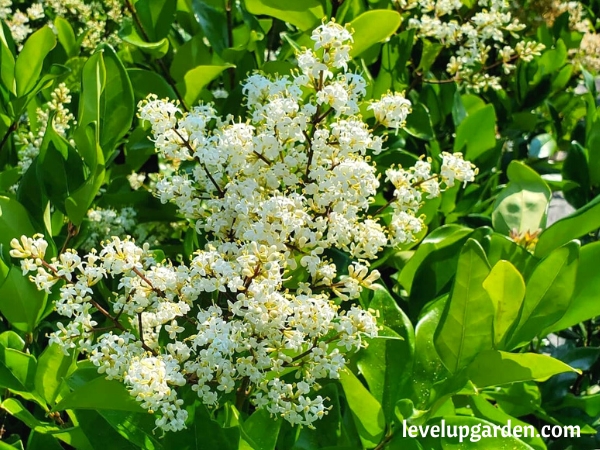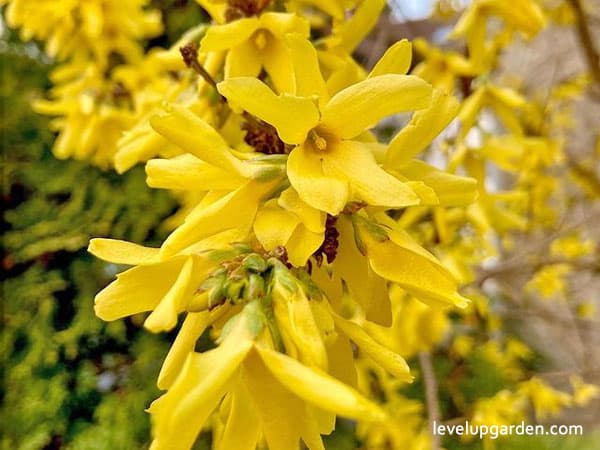The Waxleaf Privet (Ligustrum japonicum ‘Texanum’) is the potter’s wheel of the plant world. It can easily be made into any shape that suits your garden. A little pruning can transform it from a free-form bush covered with tiny white flowers to an elegant, well-formed topiary.

Waxleaf privet can be a central specimen plant in the garden or a fence or windbreak at the edge of the property. There is little this versatile plant cannot do. In the fall, the small purple-black berries attract birds to the garden.
Waxleaf Privet is an evergreen shrub that adapts well to most landscape styles in the Southwest. Hailing from northern China, Korea, and Japan, this lush, compact shrub lends itself well to topiary forms and brings a formal look to Southwestern gardens. In fact, you will often see waxleaf privet in cone, globe, or classic vertical poodle shapes adorning the landscape.
It is both heat and cold tolerant, allowing it to grow lush foliage all year round. This evergreen shrub will provide your garden an accent all year round. It needs little to moderate watering and will grow in full sun or semi-shade.
This small to medium-sized shrub is easy to care for, grows quickly, and blooms profusely in the spring. Fragrant white flowers bloom in spring, attracting hummingbirds and other pollinators. A landscaping plant staple in the Southwest, this bird-friendly shrub brings nature back to urban yards and coastal homes.
It requires less maintenance than other hedges, that is why it is often planted as a privacy hedge for windbreak between homes. If you live near a busy road, you will appreciate its excellent soundproofing.
I. Plant Profile – An Overview of the plant
| Common name | Waxleaf Privet, Waxleaf Privet Hedge |
| Botanical Name | Ligustrum japonicum ‘Texanum’ |
| Hardiness Zone | 7-11 |
| Type | Evergreen |
| Sun Exposure | Full-Partial |
| Mature Height | 8-10 ft. |
| Mature Width | 4-6 ft. |
| Growth Rate | Fast |
| Soil | Well Drained |
II. Appearance
Ligustrum Japonicum ‘Texanum’ is a shrub most commonly used as an evergreen hedge 8 to 10 feet tall. Select the height you want to maintain and cut the tips to prevent them from growing taller, which will result in denser plants and fuller growth. It produces beautiful, fragrant, cream-white flowers for about three weeks of the year.

It has leaves that are glossy and green in color. It has a width of 1 cm and a length of about 2-3 cm. The foliage color and tones are excellent. It is often used as a hedge. It has fragrant white flowers that attract bees because their pollen blooms for about 3 weeks of the year.
The flowers are creamy white, and these beautiful flowers cover the plant from spring to summer. However, it must be allowed to grow sufficiently to produce flowers. Therefore, if it is made very tight, it will cut off the buds and will rarely bloom. It can grow up to 3.5 meters and can shade the property line. It has dense foliage and can shade the sides of buildings.
III. Growing and Care Conditions
Waxleaf Privet has dense foliage and can grow several meters, making it ideal for a privacy hedge. A few of these shrubs in a row can shield one from strong winds blowing from the garden.
Privet growth can be left as is, but pruning it as topiary adds to its beauty. Careful pruning can turn a privacy hedge into a topiary hedge, providing the same protection but with a cleaner cut.
Planting
It is a highly adaptable plant, but requires well-drained soil and 6-8 hours of sunlight per day. Once you have chosen a suitable location, dig a hole about two to three times the width of the shrub’s rootball. Then place the plant, re-fill with soil, and water to allow the roots to settle.

Light
It will do best with at least 6 hours of direct sunlight per day. Place it in your garden where it can receive the sunlight that it needs.
Watering
During the first growing season of waxleaf, water deeply and regularly to establish the root system. Check to see if the soil is dry around 2 to 3 inches below the surrounding soil.
Fertilizer
Waxleaf Privet Shrub should be fertilized with a general purpose fertilizer in early spring, before new shoots emerge. This plant is not very particular with fertilizer but will surely benefit from a good fertilizer.
Soil Requirements
Ligustrums are not very particular about soil quality, but prefer well-drained soil of average fertility. Like many other houseplants, soil that is constantly wet can cause root rot and other harmful plant diseases. Therefore, be sure to plant in a well-drained area.
Waxleaf Privet grows best in medium acidic to slightly alkaline soils with a pH of 6.0 to 8.0. Typical garden soils range from pH 6.0 to 7.0. No additional fertilizer is needed if the pot is replanted every time it doubles in size.
Mulch
Waxleaf Privet is disease and pest resistant and tends to grow well without much work. Planting them in a well-ventilated location will help you as a parent.
Pruning
Pruning of the Waxleaf Privet should be done at the discretion of the individual. If not pruned, the tree will have a beautiful rounded shape. However, it can be trimmed to any desired shape, such as spherical or pyramidal. Be careful not to prune too much, however, as this will reduce flowering. Even if you do not prune, be sure to keep an eye on the plant and remove dead, diseased, or damaged branches as you find them.
Pests and Diseases
Waxleaf privets are fairly easy to care for, but there are a few things to keep in mind. Thrips and mites can cause yellowing of the leaves, but should not be a concern in a healthy hedge. Soil nematodes are roundworms that infest the soil and can cause dieback. Make sure your hedges are well fertilized and watered to discourage them.
Verticillium wilt can also affect bushes, causing yellowing of the leaves and wilting of the branches. If you think your plant has this disease, consult an arborist. There is no cure or treatment, and you will need to prune the infected area or, in severe cases, remove the entire plant.
Pollination
In spring, it produces many small white flowers that delight many pollinators, including butterflies and bees. The pollinated flowers turn into small dark blue berries in the fall. These berries are a favorite food of the Bunting bird, but are poisonous to humans. Note that trees that are strongly pruned in a topiary shape may not flower as much due to the pruning of the new shoots.
IV. Uses
Waxleaf (Ligustrum japonicum ‘Texanum’) is a common hedge plant that is ideal for creating privacy and shelter in garden borders. Not only is it evergreen and fast-growing, but it also grows in height. The dense growth of its branches and leaves makes it an ideal plant for privacy. The waxy, smooth leaves are a characteristic of this plant.

But Waxleaf Privet is more than just a column of green leaves several meters tall. Like most hedges, it grows quickly and can be pruned into a variety of shapes to suit the needs of its growing area.
This is a low, slow-growing variety that grows only about 9 feet tall but is generally smaller. It is a dense, compact, evergreen shrub with thick, round, waxy leaves that are glossy green above and whitish below. It produces fragrant, bee-appealing white flowers in late spring and early summer, followed by blue-black berries.
V. Why should you buy this plant
Waxleaf Privet Hedge is what you imagine richly colored and glossy evergreen foliage should look like. With regular pruning, this adaptable hedge can be made into formal topiary, clip hedges, or small standard tree specimens.

Plus, it is versatile enough to be used along the shore, in containers, windbreaks, and more. The possibilities for enjoying Waxleaf Privet are endless. Plus, its fragrant white flowers bloom in the spring and are uniquely beautiful.
The brightly colored, glossy evergreen foliage can be shaped as needed, making waxleaf privet hedges easily versatile. In particular, with regular pruning, it can be made into a formal topiary, a trimmed hedge, or a small single tree.
It is also ideal for coastal areas, containers, and as a windbreak. Waxleaf privet is highly adaptable and can be used for many things. Plus, it provides visual pleasure with its many fragrant white flowers in the spring. Waxleaf Privet makes a healthy and beautiful homescape in any border, foundation, or focal point.
VI. FAQs
How fast does Waxleaf privet grow?
Once planted, it is drought tolerant and moderately salt tolerant. The growth rate is about 2 feet per year and mature trees can reach 8-10 feet or more in height and width.
Is Waxleaf Privet invasive?
It becomes a weed in disturbed areas, escapes and naturalizes in wet areas, and is considered invasive in some parts of the United States. The berries produced by this plant are toxic. Dogs may be adversely affected if they eat the berries or leaves.
How do I grow Waxleaf Privet shrubs?
Dig a hole to plant the shrub that is the same depth as the rootball and 2 to 5 times as wide. Plant multiple Waxleaf Privet spaced 4 feet apart for informal hedges and 2 feet apart for formal hedges. Leave 4 feet between shrubs and other shrubs or trees.








118 responses to “Waxleaf Privet (Ligustrum japonicum ‘Texanum’)”